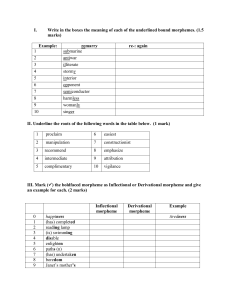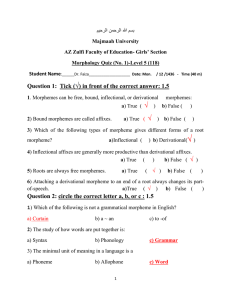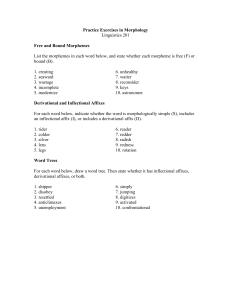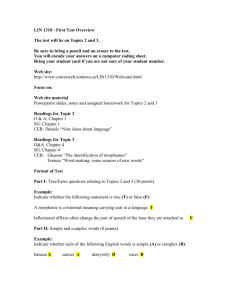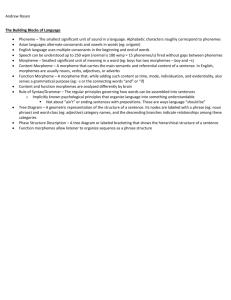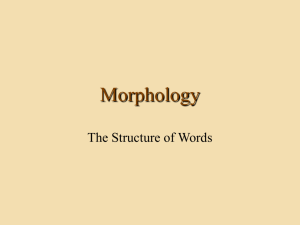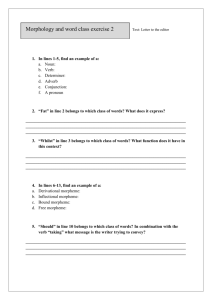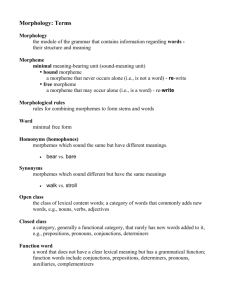Chapter Three Lexicon
advertisement
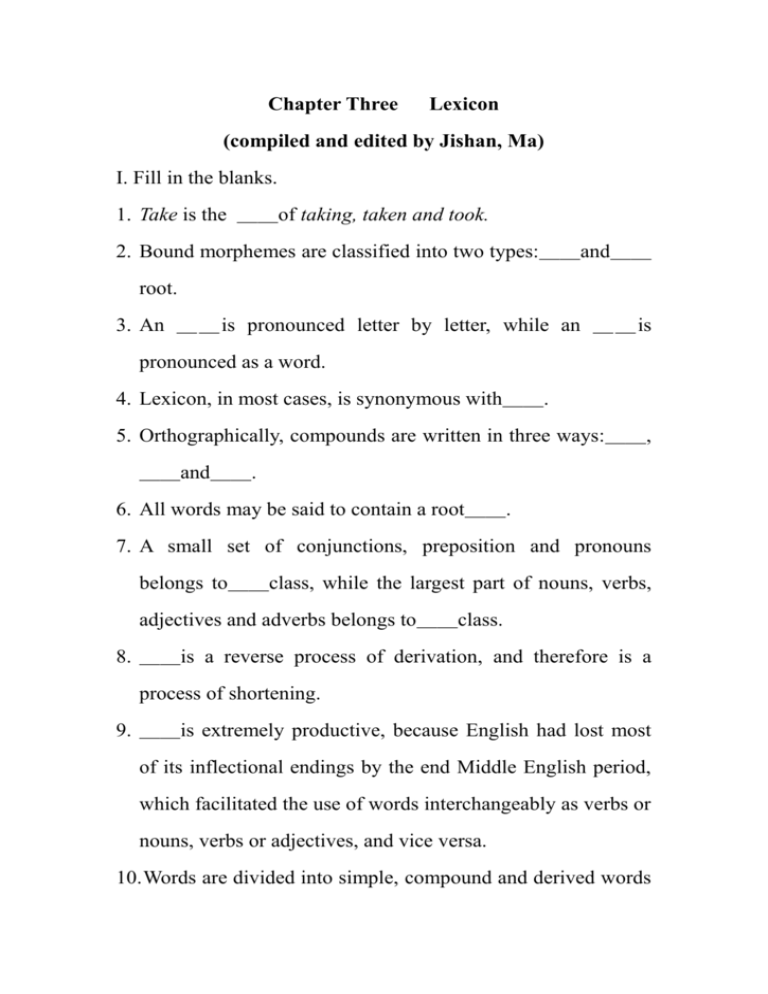
Chapter Three Lexicon (compiled and edited by Jishan, Ma) I. Fill in the blanks. 1. Take is the __of taking, taken and took. 2. Bound morphemes are classified into two types:__and__ root. 3. An __is pronounced letter by letter, while an __is pronounced as a word. 4. Lexicon, in most cases, is synonymous with__. 5. Orthographically, compounds are written in three ways:__, __and__. 6. All words may be said to contain a root__. 7. A small set of conjunctions, preposition and pronouns belongs to__class, while the largest part of nouns, verbs, adjectives and adverbs belongs to__class. 8. __is a reverse process of derivation, and therefore is a process of shortening. 9. __is extremely productive, because English had lost most of its inflectional endings by the end Middle English period, which facilitated the use of words interchangeably as verbs or nouns, verbs or adjectives, and vice versa. 10. Words are divided into simple, compound and derived words on the__level. 11. A word formed by derivation is called a __,and a word formed by compounding is called a __. 12. The poor is an example of __conversion. II.Choose the best answer. 13. Nouns, verbs and adjectives can be classified as__. A. lexical words B. grammatical words C. function words D. form words 14.Morphemes that represent tense, number, gender and case are called__morpheme. A. inflectional C. bound B. free D. derivational 15.There are __morphemes in the word denationalization? A. three B. four C. five D. six 16.In English–ise and–tion are called__. A. prefixes B. suffixes C. infixes D. free morphemes 17.Morphology is generally divided into two fields: the study of word–formation and__. A. affixation B. etymology C. inflection D. root 18.The three subtypes of affixes are: prefix, suffix and__. A. derivational affix B. inflectional affix C. infix D. back–formation 19.__is a way in which new words may be formed from already existing words by subtracting an affix which is thought to be part of the old word. A. Affixation B. Back–formation C. Insertion D. Addition 20.The word TB is formed in the way of__. A. acronymy B. clipping C. initialism D. blending 21.There are different types of affixes or morphemes. The affix “ed”in the word “learned” is known as a(n)__. A. derivational morpheme B. free morpheme C. inflectional morpheme D. free form 22.The words like comsat and sitcom are formed by __. A. blending B. clipping C. back-formation D. acronymy 23.The stem of disagreements is__. A. agreement B. agree C. disagree D. disagreement 24.All of them are meaningful except for__. A. lexeme C. morpheme B. phoneme D. allomorph III.Decide whether the following statements are true [T]or false[F]. _25.Phonetically,the stress of a compound always falls on the first element, while the second element receives secondary stress. _26.Fore as in foretell is both a prefix and a bound morpheme. _27.Base refers to the part of word that remains when all inflectional affixes are removed. _28.In most cases, prefixes change the meaning of the base whereas suffixes change the word—class of the base. —29.Conversion from noun to verb is the most productive process of conversion. —30.Reduplicative compound is formed by repeating the same morpheme of a word. —31.The words whimper, whisper and whistle are formed in the way of onomatopoeia. —32.In most cases, the number of syllables of a word corresponds to the number of morphemes. —33.Back-formation is a productive way of forming nouns in Modern English. —34.Inflection is a particular way of word—formations. 35.We can always tell by the words a compound contains what it means because the meaning of a compound is always the sum of the meanings of its parts. —36.All roots are free and all affixes are bound. IV.Explain the following terms. 37.Morphology 38.Allomorph 39.Bound morpheme 40.Back clipping 41.Derivation 42.Morphological rule 43.Closed–class word 44.Analogy 45.Full conversion 46.Blending 47.Base 48.Hybrid V. Answer the following questions. 49.Of all the word–formations, which involve the process of addition? Which the process of subtraction? And which the process of transition? 50.Illustrate the axiom, “The actual grammatical classification of any word is dependent upon its use.”
